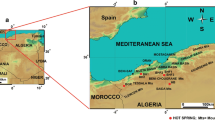Conclusions
-
1.
Crystalline rock masses are not only permeable, but hydraulically continuous and geochemically active. The mass and energy exchange with host rocks in the migration process of fissure waters alter the physical properties and chemical and isotopic compositions of both fissure waters and their host rocks. It is for this reason that the geochemical peculiarities of both fissure waters and their media contain abundant information about their hydrodynamic environment. The acquisition and interpretation of hydrochemical and isotopic data proved to be an effective way to verify the hydraulic continuity of fissured media.
-
2.
The movement of fissure water is variable both in time and in space. The distribution of sinters and the change of their compositions record the evolution of fissure water flow. The variability of fissure water flow in space, on the other hand, often causes remarkable difference in the chemical and isotopic compositions of fissure waters from the same area. On the premise of the verification of hydraulic continuity, system analysis and numerical modelling of fissure waters can be made on different scales.
Similar content being viewed by others
References
Frape. S. K., Fitz, P. Geochemical trends from groundwaters from the Canadian Shield.Geol. Assoc. Canada Spec. Paper 33. 1987, 19.
Harms, U., Figgemeier, C., Huenges, E.et al., Recent results of 7 km ultradeep drilling, KTB fluids and their pathways in the Variscan basement of Germany, inGeofluids ’93 Extended Abstracts, London: British Gas, 1993, 37–39.
Peters, E. K., D-18O enriched waters of the Coast Range mountains,Geochimica et Cosmochimica Acta, 1993, 57(4): 1093.
Kelly, W. C., Rye, R. O., Livnat, A., Saline minewaters of the Keweenaw Peninsula, northern Michigan: their nature, origin, and relation to similiar deep waters in the Precambrian crystalline rocks of the Canadian Shield,American Journal of Science, 1986, 286(4): 281.
Wang Yanxin, Sun Lianfa, Sun Xiushanet al., Geochemistry of thermal-mineral waters in the Siping’ an district, Shanxi Province, China,Journal of China University of Geosciences (in Chinese), 1994, 5(1): 79.
Toth, J., Cross-formational gravity-flow of groundwater: a mechanism of the transport and accumulation of petroleum (the generalized hydraulic theory of petroleum migration), inProblems of Petroleum Migration, A. A. P. G., 1980, 121–167.
Tolstishin, I. N., Kamenskii, I. L., About the possibility of determining the age of groundwater by using tritium-helium-3 method,Geochemistry (in Russian), 1969, (8): 1027.
Sandimirova, G. P., Lomonosov, I. S., Pohol’ chenko, U. A.et al., The genesis of natural waters from the north Muyisk tunnel area according to strontium isotope data, inHydrogeology and Genesis of Chemical Compositions of Waters (in Russian), Novosiberiask: Nauka, 1989, 98–110.
Author information
Authors and Affiliations
About this article
Cite this article
Wang, Y., Khaustov, A.P. Geochemical and isotopic imprints of hydrodynamic environments of fissure waters in crystalline rocks. Chin.Sci.Bull. 42, 756–761 (1997). https://doi.org/10.1007/BF03186971
Received:
Issue Date:
DOI: https://doi.org/10.1007/BF03186971




